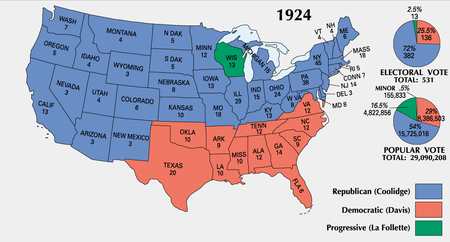U.S. presidential election, 1924
|
|
The U.S. presidential election of 1924 was won by incumbent President Calvin Coolidge in a landslide as he presided over a booming economy at home and no visible crises abroad.
| Contents |
Nominations
Republican Party nomination
The Republican Convention was held in Cleveland from 10 June to 12 June, with the easy choice of nominating sitting President Coolidge for a full term of his own.
Democratic Party nomination
The 1924 Democratic National Convention was held in New York from 24 June to 9 July. The Convention was split over more than a hundred ballots between William G. McAdoo of California, former Secretary of the Treasury and son-in-law of former President Woodrow Wilson, supported by the "Drys" (pro-Prohibitionists) and Governor Al Smith of New York, supported by the "Wets," as well as over a proposed platform plank denouncing the Ku Klux Klan (which was opposed by William Jennings Bryan). Senator Oscar W. Underwood of Alabama, the Democratic leader in the Senate, also had some support. Ultimately, the convention decided on John W. Davis, a former Congressman from West Virginia and Ambassador to the United Kingdom, as a compromise candidate.
Other nominations
United States Progressive Party candidate Robert M. La Follette, Sr. received 4,822,856 popular votes for President (16.5 percent) and 13 electoral votes. Long a champion of farmers and industrial workers, and an ardent foe of big business, LaFollette was a prime mover in the recreation of the Progressive movement following World War I. Backed by the farm and labor vote, as well as by Socialists and remnants of Theodore Roosevelt's Bull Moose Party, LaFollette ran on a platform of nationalizing railroads and the country's natural resources. He also strongly supported increased taxation on the wealthy and the right of collective bargaining. Despite a strong showing in certain regions, he carried only his home state of Wisconsin.
General election
Campaign
Ultimately, Coolidge won the election in a landslide, with Davis only winning the 11 former Confederate states and Oklahoma, and losing the popular vote by 25 percentage points.
Results
Template:Start U.S. presidential ticket box Template:U.S. presidential ticket box row Template:U.S. presidential ticket box row Template:U.S. presidential ticket box row Template:End U.S. presidential ticket box (a) Template:U.S. popular vote total disclaimer
Source: U.S. Office of the Federal Register (http://www.archives.gov/federal_register/electoral_college/scores.html#1924)
See also
Template:Uspresidentialelections
(Some article text as of January 9, 2003 copied from U.S. State Department (usinfo.state.gov) (http://usinfo.state.gov/usa/infousa/facts/history/ch13.htm#1992))

